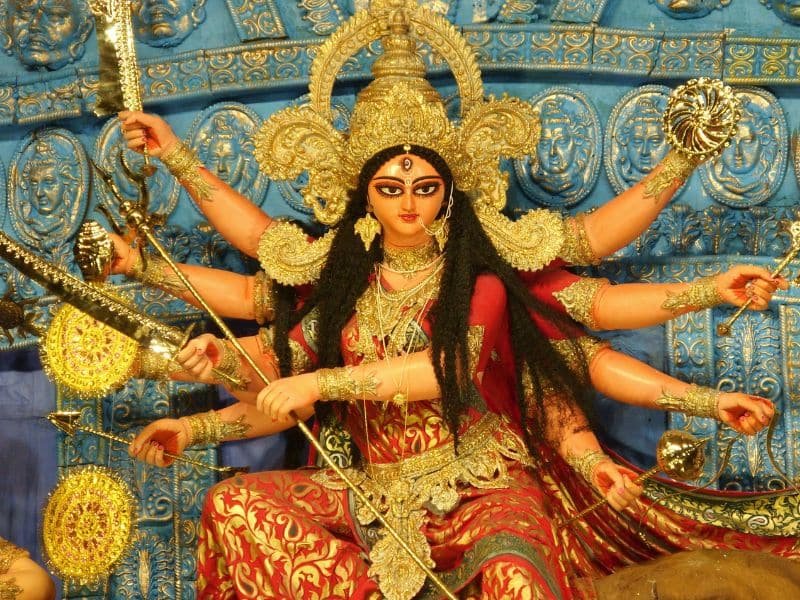Navratri is one of the most significant Hindu festivals, celebrated with immense devotion and fervor across India and among Hindu communities worldwide. This nine-day festival is dedicated to the worship of Goddess Durga and her nine forms, symbolizing the triumph of good over evil. In 2024, Navratri will begin on Saturday, October 3rd, and will end on Sunday, October 12th.
Key Details of Navratri 2024:
- Start Date: Thursday, October 3, 2024
- End Date: Sunday, October 12, 2024
- Duration: 9 Days

What is Navratri?
The word “Navratri” is derived from two Sanskrit words: ‘Nava’ meaning nine and ‘Ratri’ meaning nights. Navratri is celebrated twice a year, once in the spring (Chaitra Navratri) and once in the autumn (Sharad Navratri). The Sharad Navratri, which falls in September-October, is the most prominent and widely celebrated.
During these nine days, devotees observe fasting, engage in prayers, perform rituals, and participate in traditional dances like Garba and Dandiya, especially in Gujarat and Maharashtra. Each day is dedicated to one of the nine forms of Goddess Durga, known as Navdurga. The festival culminates on the tenth day, known as Vijayadashami or Dussehra, which marks the victory of Lord Rama over the demon king Ravana in the Ramayana.
Daily Significance of Navratri
Each day of Navratri is associated with a different manifestation of Goddess Durga:
Day 1: Shailaputri – Goddess of the Mountains
Day 2: Brahmacharini – The Ascetic Goddess
Day 3: Chandraghanta – The Goddess of Peace and Serenity
Day 4: Kushmanda – The Creative Power of the Universe
Day 5: Skandamata – The Mother of Skanda (Kartikeya)
Day 6: Katyayani – The Warrior Goddess
Day 7: Kalaratri – The Fearsome Goddess
Day 8: Mahagauri – The Goddess of Purity
Day 9: Siddhidatri – The Goddess of Supernatural Powers
How is Navratri Celebrated?
Navratri is celebrated with various rituals and customs across different regions of India:

North India:
In North India, Navratri is observed with deep devotion and a range of rituals that honor Goddess Durga. Among the most significant practices are fasting and Kanya Puja. Devotees often fast for all nine days, consuming only specific foods to purify the body and mind, with the goal of deepening their spiritual connection.

West India:
Gujarat is renowned for its vibrant celebration of Navratri, particularly through the energetic Garba and Dandiya Raas dances. These traditional folk dances are performed in the evenings after the worship of Goddess Durga. Garba involves rhythmic clapping and circular movements around a centrally placed lamp or the idol of the Goddess, symbolizing the cycle of life.

South India:
During Navratri in South India, especially in Tamil Nadu, Karnataka, and Andhra Pradesh, families arrange a display called ‘Golu’ or ‘Bommai Golu.’ This involves the artistic and thematic arrangement of dolls and figurines on tiered steps. These dolls represent gods, goddesses, mythological scenes, and various aspects of life.

East India:
In West Bengal, Durga Puja is the central focus of Navratri celebrations, marked by elaborate and artistic grandeur. The festival is celebrated with immense enthusiasm, with grand pandals set up across cities and villages to house magnificent idols of Goddess Durga. These pandals are often designed around unique themes, showcasing intricate artistry and creativity.
Navratri in 2024 will be celebrated from October 3rd to October 12th, marking nine days of devotion, prayer, and celebration. It is a time to honor the divine feminine energy and seek blessings for prosperity, health, and well-being. Whether you observe Navratri through fasting, dance, or prayer, the festival’s essence remains in celebrating the victory of light over darkness and good over evil.

